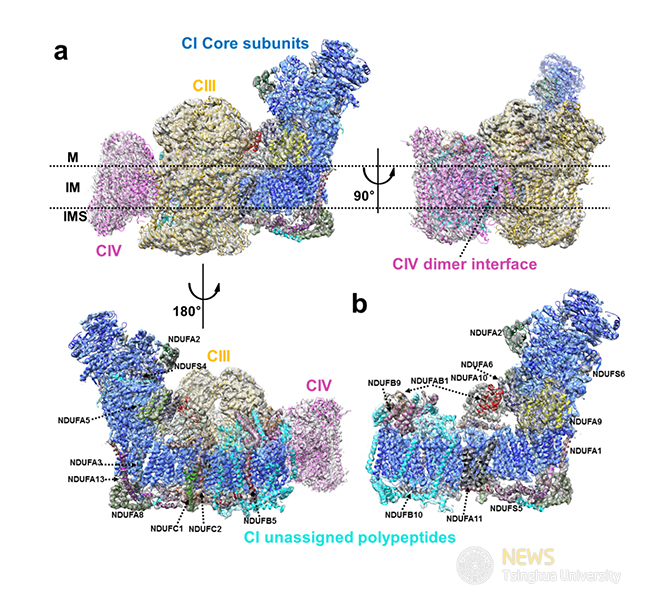Maojun Yang’s Group Published the Structure of Respirasome in Nature
On September 21st 2016, a research team led by Professor Maojun Yang from the School of Life Sciences, Tsinghua University published an article entitled “The Architecture of the Mammalian Respirasome” in Nature which has reported the highest resolution cryo-EM structure of mitochondria respirasome (1). This work is the second breakthrough by Prof. Yang in the area after reporting the structure of type-II mitochondria complex I in Nature in 2012 (2). The structure of respirasome, which is the largest and most complicated membrane protein complex identified to date, provides insight into the organization of mammalian respiratory chain as well as the mechanism of proton pumping and electron transfer, ultimately provides critical information into the treatment of cellular-respiration related diseases.
Respiration is the most basic activity of all living organisms. Respirasome abnormality in human can lead to various serious diseases, including Alzheimer’s and Parkinson’s diseases, multiple sclerosis, Friedreich’s ataxia and amyotrophic lateral sclerosis. Respirasome, which is a gigantic molecular machine responsible for cellular respiration, locates in the inner mitochondrial membrane (IMM). In 1997, American scientist Hackenbrock proposed the fluid model claiming that four protein complexes, including NADH dehydrogenase (CI), succinate dehydrogenase (CII), cytochrome bc1 complex (CIII) and cytochrome c oxidase (CIV), are separately scattered in the IMM, and each of them catalyzes one step of respiration, while since 2000, more and more evidence shows these complexes are not independent from of each other, but can combine to form a higher order structure, supercomplex (SC). Different combination types can form different supercomplexes, among which SCI1III2IV1 is the most abundant and important.
Mammalian respirasome is composed of 81 protein subunits, and has a molecular weight of about 1.7 MDa. Crystallization is not feasible in resolving the structure of respirasome due to the weak interactions between each individual protein complex, while the protein complex exhibit promising behavior in cryo-EM analysis. By optimizing the purification procedure, Prof. Yang’s group finally obtained stable and homogeneous protein samples. Thanks to the support of the Beijing Advanced Innovation Center for Structural Biology, high quality cryo-EM data were acquired. Through single particle 3D reconstruction, a structure with an overall resolution of 5.4 angstrom was determined, with the sub-regions CI and CIII both refined to a resolution of 3.97 angstrom. Independently, two other groups have recently reported the structure of mammalian CI at 3.9 angstrom and 4.2 angstrom respectively in Nature (3,4), thus further supporting the results in Prof. Yang’s study.
This structure provides detailed information on the interactions between CI, CIII and CIV. The interaction between CI and CIII is rather stable. NDUFA11 of CI directly interacts with both CI and CIII, while the N-lobe of NDUFB9 assists in the binding of CI and CIII. CIV binds relatively loosely to CI and CIII. COX7C (subunit of CIV) is packed against the last TMH of ND5 at the distal end of CI’s membrane arm. Additionally, at the matrix side, COX7A (subunit of CIV) contacts with both UQCRC1 and UQCR11 (subunits of CIII). Perhaps due to the lack of supernumerary subunits from CI functioning as bridge, these interactions are slightly weaker compared to CI-CIII interaction.
Moreover, when compared with CI in the free form, the matrix arm of CI and the distal end of CI’s membrane arm bend towards the central part of CI’s membrane arm in the respirasome in order to interact with CIII and CIV. Furthermore, this work provides evidence for substrate channeling. Ubiquinone is supposed to be trapped in the gap between CI and CIII, which is filled with lipid molecules, and this compartmental arrangement can greatly increase the efficiency of ubiquinone transport. At the IMS side, the binding site of Cyt.c in CIII and CIV are located in close proximity within 10 nm in the plane formed by TMH ends of CI, CIII and CIV. This feature vastly facilitates Cyt.c communicating between CIII and CIV.
Ph.D student Jinke Gu, CLS student Meng Wu and Master student Runyu Guo from Prof. Yang’s group are co-first authors of this work; Prof. Ning Gao from the Tsinghua University and Prof. Maojun Yang are the corresponding authors ; Ph.D student Kaige Yan from Prof. Ning Gao’s group participated in the research before graduating; Director of the Cyro-EM Platform in Tsinghua University, Jianlin Lei, provided technical support; Primary investigator Xueming Li, Ph.D students Fan Yang and Yan Li from the Tsinghua University Branch of China National Center for Protein Sciences provided valuable suggestions. Data collection was performed on the Cyro-EM Platform, and computing work was supported by the Tsinghua University High Performance Computing Cluster. This work was founded by the Beijing Advanced Innovation Center for Structural Biology, Tsinghua University Branch of China National Center for Protein Sciences, Tsinghua-Peking Joint Center for Life Sciences, Ministry of Education Key Laboratory of Protein Science, Ministry of Science and Technology, the National Science Fund for Distinguished Young Scholars, and National Natural Science Foundation of China.

Figure Legend: a, side views of the model and density of respirasome structure. b, model and density of complex I structure.
Link: http://www.nature.com/nature/journal/vaop/ncurrent/full/nature19359.html
Reference:
J. Gu et al., The architecture of the mammalian respirasome. Nature, (2016).
http://www.nature.com/nature/journal/vaop/ncurrent/full/nature19359.html
Y. Feng et al., Structural insight into the type-II mitochondrial NADH dehydrogenases. Nature 491, 478-482 (2012).
http://www.nature.com/nature/journal/v491/n7424/full/nature11541.html
J. Zhu, K. R. Vinothkumar, J. Hirst, Structure of mammalian respiratory complex I. Nature 536, 354-358 (2016).
http://www.nature.com/nature/journal/v536/n7616/full/nature19095.html
K. Fiedorczuk et al., Atomic structure of the entire mammalian mitochondrial complex I. Nature, (2016).
http://www.nature.com/nature/journal/vaap/ncurrent/full/nature19794.html
(edited by Li Huashan)

